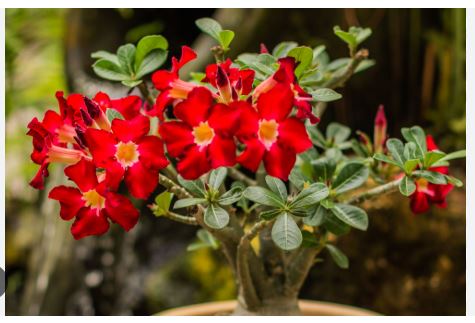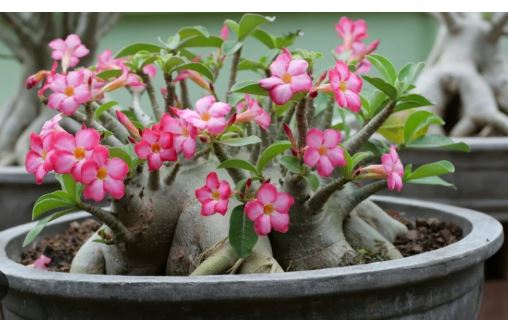
Desert Rose, scientifically known as Adenium obesum, belongs to the Apocynaceae family, which includes other ornamental plants like oleander and periwinkle. It is part of the genus Adenium, comprising about 5–12 species of succulent shrubs and trees native to Africa and the Arabian Peninsula. The species name obesum refers to its thickened, often swollen stems, a characteristic adaptation for water storage.
Previously classified under a broader Adenium species, taxonomic revisions have distinguished A. obesum as the primary cultivated species, with subspecies like A. obesum subsp. somalense. Its placement in Apocynaceae reflects traits like milky sap and showy flowers, shared with related genera.
Desert Rose is a slow-growing, evergreen or semi-evergreen succulent shrub or small tree, typically reaching 3–9 feet tall and 3–5 feet wide in cultivation, though it can grow taller in the wild. Its thick, glossy, dark green leaves, 2–6 inches long, are spirally arranged and often clustered at branch tips, shedding partially in cooler seasons.
The plant’s hallmark is its bottle-shaped, swollen stem (caudex), which stores water and gives it a bonsai-like appearance. Vibrant, trumpet-shaped flowers, 2–3 inches wide, bloom in shades of pink, red, white, or bicolor, often with a yellow throat, from spring to fall. Small, linear seed pods release tufted seeds when mature. Cultivars like ‘Black Ruby’ or ‘Double Yellow’ offer diverse flower colors.
Desert Rose is native to arid and semi-arid regions of eastern and southern Africa, from Senegal and Sudan south to Mozambique and Zimbabwe, and across the Arabian Peninsula, including Yemen and southern Saudi Arabia. It thrives in rocky outcrops, dry savannas, and scrublands, often on well-drained, sandy, or gravelly soils in areas with minimal rainfall.
Widely cultivated as an ornamental, it has been introduced to tropical and subtropical regions, including Asia (e.g., Thailand, India), the Caribbean, and the Americas, particularly in desert climates like Arizona and Florida. It does not naturalize aggressively but is a staple in succulent collections and xeriscape gardens.
Adenium obesum is hardy in USDA Zones 10–11, tolerating temperatures down to about 35°F (2°C), though it prefers warmth above 50°F (10°C). Frost-sensitive, it suffers damage below 35°F and requires protection in cooler climates. In Zones 8–9, it is grown as a container plant, moved indoors during winter, or treated as an annual. It thrives in full sun and high heat, making it ideal for desert and tropical regions, but it needs well-drained soil and careful watering to prevent rot in humid areas.
Desert Rose is primarily an ornamental plant, prized for its sculptural caudex, vibrant flowers, and drought tolerance, making it a favorite for xeriscape gardens, rock gardens, and as a potted specimen. Its bonsai-like form is popular in container gardening and succulent collections, often trained to enhance its gnarled, artistic shape. The flowers attract pollinators like bees and butterflies, adding ecological value.
In its native regions, the milky sap, though toxic, has been used traditionally for arrow poison and fish stunning, and some cultures use it medicinally with caution. Modern uses avoid toxicity risks, focusing on aesthetics. Its compact size and low water needs make it ideal for patios, courtyards, or indoor settings with bright light. Note that all parts are poisonous, requiring care around pets and children.

Desert Rose (Adenium obesum): How To Grow And Care
Select a Bright, Sunny Location
Choose a site with full sun, providing at least 6–8 hours of direct sunlight daily to promote flowering and healthy growth. In hotter climates, light afternoon shade can prevent leaf scorch. For indoor or container plants, place near a south-facing window or under grow lights. Ensure the location accommodates its mature size, typically 3–9 feet tall and 3–5 feet wide, or smaller in pots.
Use Well-Drained, Gritty Soil
Plant in a fast-draining, sandy, or gritty soil mix with a pH of 6.0–7.5, mimicking its arid native habitat. A cactus or succulent potting mix with added perlite, pumice, or coarse sand (50:50 ratio) is ideal. Avoid heavy, clay-rich soils that retain moisture, as Desert Rose is prone to root rot. For potted plants, ensure containers have drainage holes to prevent water accumulation.
Plant or Repot Carefully
Plant or repot in spring, the start of the growing season, to encourage root establishment. For ground planting, dig a hole twice as wide and as deep as the root ball, keeping the caudex slightly above soil level to showcase its form. For containers, choose a wide, shallow pot to support the swollen stem. Water lightly after planting and avoid disturbing the roots, as the plant is sensitive to transplant shock.
Water Sparingly and Seasonally
Water moderately during the growing season (spring–summer), allowing the top 1–2 inches of soil to dry out between waterings, typically every 7–10 days. In fall and winter, reduce watering to once every 2–4 weeks, especially if the plant is dormant (leaves drop). Overwatering is the primary cause of root rot, so err on the side of underwatering, particularly in humid climates or indoors.
Mulch Lightly for Containers
For ground-planted Desert Rose, apply a thin (1-inch) layer of gravel or coarse sand around the base to mimic desert conditions, improve drainage, and deter weeds, keeping it away from the caudex. In containers, a top dressing of pebbles or pumice enhances aesthetics and prevents soil compaction. Avoid organic mulch like bark, which retains moisture and risks rot.
Fertilize During Active Growth
Feed monthly during spring and summer with a balanced, water-soluble fertilizer (e.g., 20-20-20) diluted to half strength, or use a cactus-specific formula high in phosphorus to boost flowering. Apply to moist soil to prevent root burn. Suspend fertilization in fall and winter when growth slows or the plant enters dormancy, as excess nutrients can harm the plant.
Prune for Shape and Health
Prune in early spring to shape the plant, encourage branching, or enhance its bonsai-like form. Remove dead, leggy, or overcrowded stems using clean, sharp tools, and cut above leaf nodes to promote new growth. Pinch back tips for bushiness or lift the caudex over time for a dramatic effect. Wear gloves, as the sap is toxic and can irritate skin or eyes.
Monitor for Pests
Desert Rose is susceptible to spider mites, mealybugs, and scale, especially indoors or in dry conditions. Check for webbing, white cottony masses, or sticky residue on leaves and stems. Treat infestations with a strong water spray, neem oil, or insecticidal soap, repeating weekly until clear. Ensure good air circulation and avoid overwatering to prevent pest issues.
Prevent Rot and Fungal Issues
Root rot and stem rot (e.g., from Fusarium or Phytophthora) are common if overwatered or poorly drained. Ensure proper soil drainage and avoid watering the caudex directly. If leaves yellow, soften, or drop excessively, inspect roots for mushiness; remove affected areas with a sterile knife and repot in fresh, dry soil. Fungal leaf spots can be treated with fungicides if detected early.
Protect from Cold and Frost
Hardy in Zones 10–11, Desert Rose is frost-sensitive and damaged below 35°F (2°C). In Zones 8–9, grow in containers and move indoors during winter, placing in a bright, warm spot (above 50°F/10°C). For ground plants in marginal zones, cover with frost cloth during cold snaps and mulch the root zone with gravel. Avoid sudden temperature drops, which stress the plant.
Encourage Pollinator Activity
The plant’s vibrant flowers attract bees, butterflies, and hummingbirds during spring-to-fall blooms. Avoid pesticides during flowering to protect pollinators. Pair with desert natives like lantana or salvia in outdoor gardens to create a pollinator-friendly landscape, enhancing biodiversity while complementing the Desert Rose’s aesthetic.
Propagate with Caution
Propagate via stem cuttings or seeds in spring or summer. For cuttings, take 4–6-inch healthy stems, let them callus for 2–3 days, and plant in a gritty mix with rooting hormone, keeping slightly moist until rooted (4–6 weeks). Seeds, sown in a warm, well-drained mix, germinate in 1–2 weeks but may not produce true-to-type plants. Handle carefully, as all parts are toxic.
Select or Train for Desired Form
Choose nursery plants with a well-formed caudex or vibrant flower colors, such as cultivars like ‘Black Ruby’ (dark red) or ‘Golden Bell’ (yellow). For bonsai or artistic forms, gradually lift the caudex over years by repotting higher or prune branches to create a gnarled look. Use shallow, decorative pots to highlight the stem, ensuring stability for top-heavy plants.
Additional Tips
- Toxicity: All parts are poisonous; keep away from pets and children, and wash hands after handling.
- Dormancy: In cooler climates, the plant may drop leaves and enter dormancy in winter; reduce watering and maintain bright light to encourage spring regrowth.
- Container Care: Repot every 2–3 years to refresh soil, choosing pots that balance the caudex’s weight and enhance its ornamental appeal.